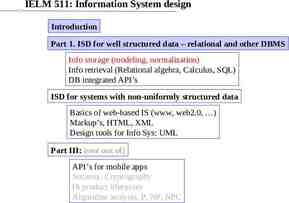SAP Overview
48 Slides1.32 MB
SAP Overview
SAP? Company ERP Software package – R/2 – R/3
Why ERP Integration Best business practices Standardization
Why not ERP? Complexity Cost Inflexibility
SAP R/3 System Business Modules Logistical Sales & Distribution Financial Financial Accounting Materials Mgmt. Controlling Production Planning Fixed Assets Mgmt. R/3 Client / Server ABAP/4 Quality Mgmt. Plant Maintenance Human Resources Project System Workflow Industry Solutions
R/3 System: Hardware/Software Views
Typical Client Server Architectures Presentation Central System Two - tier Distributed System Two - tier Client/Server Three - tier Client/Server Multi-layer Cooperative Client/Server Application Database
R/3 System Configurations Central System 2-Tier Configuration SAP 3-Tier Configuration Web-enabled Presentation Presentation Application Internet Transaction Service/Web Service Database, Application, Presentation Database and Application Database In a central R/3 System configuration, one host is responsible for all processing tasks.
R/3 System Configurations Central Systems 2-Tier Configuration SAP 3-Tier Configuration Web-enabled Presentation Presentation Application Internet Transaction Service/Web Service Database, Application, Presentation Database and Application Database Two‑tier R/3 System configurations are usually implemented using special presentation servers that are responsible solely for formatting the graphical interface. Many R/3 System users use PCs with Microsoft Windows ‑installed, for example, as presentation servers.
R/3 System Configurations Central Systems 2-Tier Configuration SAP 3-Tier Configuration Web-enabled Presentation Presentation Application Internet Transaction Service/Web Service Database, Application, Presentation Database and Application Database An alternative two‑tier configuration is to install powerful desktop systems and to use these for presentation and applications (two‑tier client/server). This type of configuration is particularly useful for expensive applications (such as simulations) or for software developers.
R/3 System Configurations Central Systems 2-Tier Configuration SAP 3-Tier Configuration Web-enabled Presentation Presentation Application Internet Transaction Service/Web Service Database, Application, Presentation Database and Application Database In a three‑tier configuration, you use your own host for the three tiers. Using data from the database server, several different application servers can operate at the same time. To ensure that the load on individual servers is as even as possible and to achieve optimal performance, you can use special application servers for individual application areas such as sales planning, distribution or financial accounting.
R/3 System Configurations Central Systems 2-Tier Configuration SAP 3-Tier Configuration Web-enabled Presentation Presentation Application Internet Transaction Service/Web Service Database, Application, Presentation Database and Application Database To web‑enable the SAP Applications, a Web Server and an ITS (Internet Transaction Server) are needed. The web‑service and the services for the ITS can run on one server or on two dedicated servers. The presentation in this configuration is provided by an Internet Browser. The new SAP Web platform is NetWeaver.
Basis System: Three-Tier Computer Hierarchy Central Database (Storage of all data) Access to Dataase: (Read / Write data) Database Input / Output of data to users Application Presentation Processing of data using application logic Presentation of the processed data to the user
Client/Server Overview Server LAN/WAN TCP / IP Client
Client/Server Overview (Logical Structure) Data Storage Application Logic Client Presentation Server
What does an R/3 Database Contain? R/3 System database Client Client Client Customizing Objects Repository Objects Global Settings SAP AG R
What is a Client? “A client is an autonomous unit in the R/3 System with regard to commercial law, organization, and data.” Client R SAP AG
Common Client Roles Development & Customizing Configuring of client settings and creation of new functionality QTST Quality Assurance Functionality testing and verification of configuration PROD Production Productive activities and business data CUST
Additional Client Roles Sandbox Sampling of customizing transactions and settings Test Testing of configuration settings with data TRNG Training End-user customer training environment PPRD Pre-production Configured environment for the load of legacy data prior to the start of productive activities SAND TEST
Sample SAP System Landscape Development Testing Database Servers Application Servers Presentation Servers Production
Object Migration Corrections and Transport Development QA Testing Program A Program A Program A Table A Table A Table A Screen A Screen A Screen A Production
Object Migration Development Program Program A A Version Version 11 Program Program A A Version Version 22 Program Program A A Version Version 33 Originals Corrections and Transport ? ? QA Testing Program Program A A Version Version 11 Program Program A A Version Version 22 Program Program A A Version Version 33
Geography-based Clients America America Europe Europe Japan Japan Client Client 010 010 Client Client 020 020 Client Client 030 030 R/3 Europe R/3 America R/3 Japan
Client Copies Configuration Development Quality Assurance Interface Testing User Training
ERP: Integration Integrate people, data and business processes within and between organizations. Collaboration, non-redundancy, consistency and internal process optimization.
Procurement Process Outline Agreement Demand Accounts Payable Purchase Requisition Invoice Verification Vendor Goods Receipt & Inventory Mgmt. Scheduling Agreement Purchase Order
Production Process Schedule/Release Goods Issue Order Settlement Shop Floor Goods Receipt
Sales Process — Trading Goods Customer Order Accounts Receivable Picking Packing Billing Goods Issue
Sales Process Finished Goods Availability Check Customer Order Final Payment Partial Payment Goods Issue Billing
Sales Process Finished Goods Availability Check - Insufficient Independent Demand Customer Order Dependent Demand MRP Run Production Scheduling Purchasing
Process Flow Goods Issue to Shop Floor Accounts Receivable Production Billing Goods Receipt Goods Issue
Logging In Basics
Client This is a numeric field. This number defines a whole business entity.
User Every SAP user has a user name. Users of SAP system are client-specific, which means that having a user identification on one client will only allow access to that particular client.
Password Rules Letters Numbers Easy to remember 3-8 Characters long No 3 Characters can be the same Do not start with a ? or an ! Do not use previous 5 passwords
Language SAP supports multi-national character sets and languages on the same system, at the same time. Default languages are English and German.
Field Types There are three types of Entry Fields – Required – Default entry – Optional entry field
Sessions An SAP session is a window in which the user may perform a particular task. A User may have up to nine sessions open at one time.
SAP R/3 Resource Management: The Dispatcher Presentation SAP GUI Communications Application Dispatcher Work Process Data base Work Process Work Process Buffers
SAP R/3 Resource Management: Data Flow Presentation SAP SAP GUI GUI Terminal Process 11 77 Application 22 Dispatcher 33 66 Data base SAP SAP Memory Memory Buffer Buffer Roll Work Process 44 Request Request queues queues Page 55 Relational Relational database database system system
SAP R/3 Resource Management: Work Processes A A B B Update Dialog Message Sold to party: C100 Sold to party: C100 Item Material Qty 10 6301 10 20 6412 10 30 1507 25 Item Material Qty 10 6301 10 20 6412 10 30 1507 25 Order M Sold to party: C100 Sold to party: C100 Item Material Qty 10 6301 10 20 6412 10 30 1507 25 Item Material Qty 10 6301 10 20 6412 10 30 1507 25 Order Background Jobs SAP Dispatcher 1 2 3 4 5 6 7 8 9 10 11 13 14 15 16 17 18 19 20 21 22 23 24 25 26 27 28 29 30 31 Order Enqueue C C Gateway 1999 12 Order Spool R/3 R/2 G
SAP R/3 Resource Management: Lock Management by the Enqueue Work Process Instance A Dispatcher Work Process Work Process Update Enqueue Message Server Instance B Dispatcher Lock table in main storage Work Process Work Process Update Enqueue
SAP R/3 Resource Management: R/3 Instance Database Database Instance Instance Message Message Server Server Instance Instance Profiles Profiles (parameters) (parameters) SAP SAP Gateway Gateway Dispatcher Dialog . Update Spool SAP SAP Buffers Buffers Start Start or or Stop Stop Background Enqueue nce a t s In Central
SAP R/3 Resource Management: Distributed SAP R/3 Processing Instance 03 Instance 02 Dispatcher Dialog Background Dispatcher Enqueue Enqueue Dialog . Instance 01 Dispatcher Dialog Update Enqueue Spool Message Gateway
Reporting Three basic steps to running a report – Access the report – Enter selection criteria – Execute the report
System Messages E - Error – An invalid entry has been made. – The cursor moves to the field where the error has occurred. W - Warning – A possible error has been made. –The user can continue without changing. I – Information – Feedback from the system.
Customizing - Modeling the Business – Organizational Structures in each module – Master Data - Customers, Materials, – Rules - required entries, tolerances,
Mapping – Assignment of organizational structures to reflect the enterprise model – Establishes integration among modules





















































